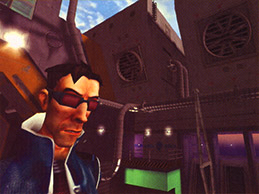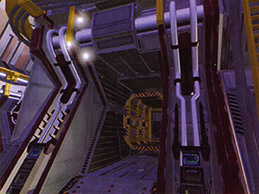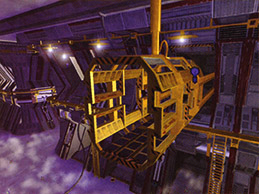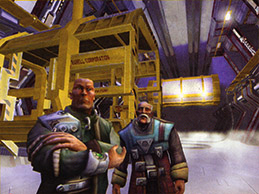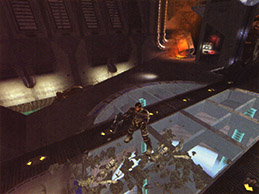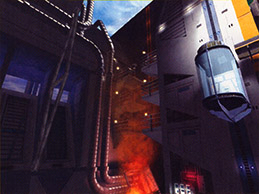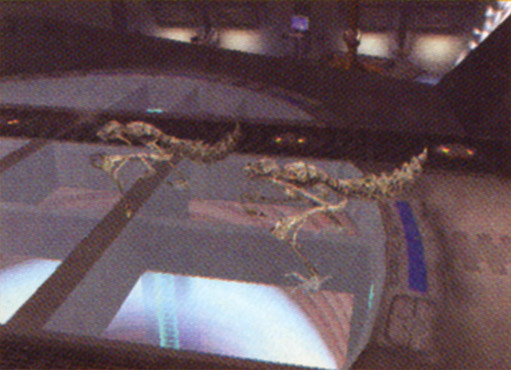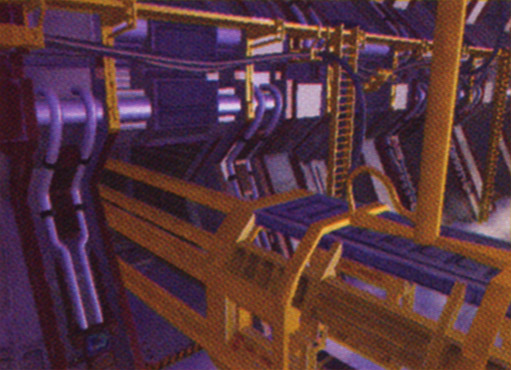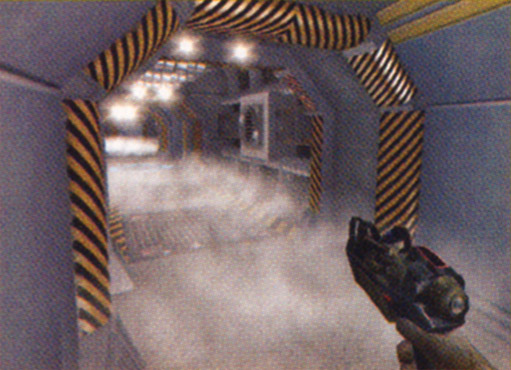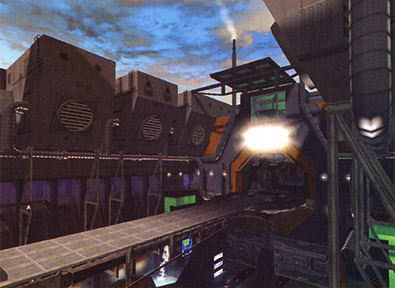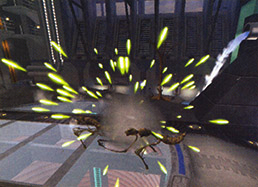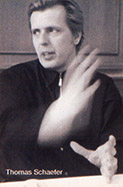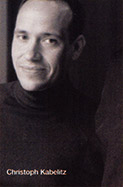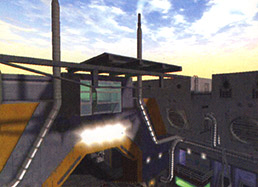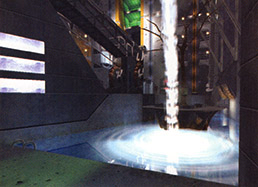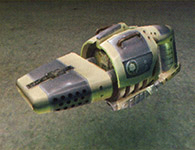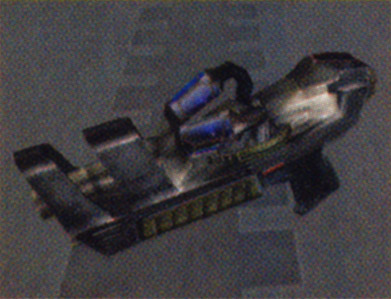
Future
Y-Project
The giant bugs are crawling, and there’s nary a Texas-sized can of Raid to be found. Welcome to the finest Xbox game still in search of a publisher …
As most of us scratch our heads at the inexplicable lack of compelling storylines in the video game canon, Tomas Schaefer is attempting to alter the existing landscape with his own unique vision of the interactive narrative. The guiding force behind a talented team at Westka Interactive, Schaefer has spent the last two years nestled in his studio in Cologne, Germany, working on the largest undertaking of his career. Speaking with Schaefer in his hotel room at the Hyatt Sinclair Hotel in a rain-drenched San Jose (where he is demonstrating the game to potential publishers attending the concurrent Game Developers conference), his excitement is immediately palpable and his vision solemnly assured. In the course of our discussion, Schaefer is partial to three words, in particular; namely, “freedom,” “systems,” and “illusion.”
On a very fundamental level, Y-Project will attempt to transcend traditional genre labels. It uses Epic’s Unreal II engine, but it is not a simple first-person shooter. It involves accumulating experience points and conversing with hundreds of other characters, but it is not a traditional role-playing game. And, crucially, it’s not some messy combination of these various forms, either. “Don’t think we’re doing a genre-blending game,” Schaefer insists with an engagingly thick German accent. “I’ve seen too many games in the last 10 years which have tried to blend two or three genres. Simply adding up the parts of different genres does not make a good game.”
Instead, Westka’s approach is to leave the structure of the gameplay as open-ended as possible, allowing sufficient elbow room for various player types and styles. By attempting to incorporate several different gameplay “systems” into the world it has created, Y-Project will essentially give the player a say in not only the course of events which take place, but the actual form these events will take as well. Schaefer explains: “Our way is to put the freedom in the player’s hands…it’s been a very long process, in which we have analyzed several different systems to put it together. If anything would speak out of the eyes of an RPG player—or a FPS player, or an action-adventure player—anything we put into the game from other genres we had to actually proof-test to be assured that it would be okay for any player type. We’re trying to maintain balance and, more importantly, freedom for the gamer.” (Despite their apparent similarities, Schaefer resists comparisons to acclaimed developer Warren Spector, maintaining that he has a “very different approach” to creating games.)
Y-Project takes place some 200 years into the future. Seventy years before the game begins, a group of humans leaves Earth—itself polluted and ravaged beyond repair—in search of new territory to settle. Prior to landing, a genetic experiment is botched onboard the spaceship and… well, we all know what happens when genetic experiments get “botched.” A failed attempt to develop a better fertilizer instead produces a mutated insect; upon landing, the insect escapes, swells to many times its original size, and reproduces exponentially. The humans are forced to move into one central, monolithic city nestled inside an enormous glass dome.
Note to self: In the future, don’t build cities inside glass domes.
Seventy years after the landing—and, effectively, the beginning of the game—the glass dome over the city is destroyed. The insects enter en masse into this once-burgeoning metropolis; most of the inhabitants are killed, leaving chaos and destruction in place of peace and prosperity. The player’s role, then, is to save the surviving humans from the insects and solve the mystery behind their existence. Two leading human factions have developed in the crippled city, both sharing the same goal. Each faction however, represents a very different political and social view; one is rooted in science, while the other, somewhat unsurprisingly, favors a more violent, military-minded approach.
In the opening scenes of Y-Project, leaders of the two factions vie with one another to recruit you into their faction. They offer you weapons, tools and other incentives, knowing that you are an important weapon against the insects. Your natural inclination towards either of these approaches will partially determine which faction you serve, while the rest will be dictated by your response to the leaders.
Throughout the game, members of each faction will attempt to recruit you for their cause. Each will reward you with special energy and items when you complete a quest for their group; in tum, you’ll be forced to make critical decisions that will significantly affect the course of the story and your own role within it. (You collect different experience points depending on the faction you are currently serving, and the XPs for each faction are counted and displayed separately.)
The player will thereby dictate his or her own style of play, and will be forced to question these beliefs after hearing compelling arguments from the leaders of each camp. “It’s more of a play of information and disinformation on both sides,” Schaefer explains. “The game is all about the way between these two factions: who to believe, whom not … and by doing so, you define the set of weapons and tools that you acquire along the way.” An interesting prospect indeed, especially during a time when war in the real world threatens to permanently alter humanity’s very existence. Romantic thinking, perhaps, but if the game’s narrative succeeds on a very base level, it may effectively illustrate the roadblock presented by a one-sided approach to resolving the current state of affairs in a way film or literature inherently cannot.
Perhaps equally impressive, however, is the sheer depth and detail with which Westka is saturating Y-Project’s environments. The cityscape is realistically delineated; ghettos line the outskirts and downtown areas, while offices become increasingly lavish and more ornate on higher floors of buildings. Museums are filled with various remains of (Earthly) human history, from atomized Coca-Cola cans to discarded Rembrandt paintings. Mundane objects have become relics; jukeboxes (or “Wurlitzer boxes,” as Schaefer refers to them), for example, sit in museums for visitors to ponder their practical use. “We’re mixing all of this together,” Schaeffer remarks, “because it’s history. And it’s a museum of the history of this Earth, which was their home planet.”
Because the game takes place in a controlled environment with a fixed number of inhabitants, the developers are able to furnish each and every non-player character in the game with an individual existence. Not only does every NPC in the game have his or her own name and backstory, but each also has a memory and a form of group Al as well. They remember when you do something which runs counter the goals of the their faction, and behave in the appropriate manner towards players who have aided their cause. This is especially relevant if the player switches factions during the game and reencounters NPCs who were previously members of the other faction.
In order to visually demonstrate Y-Project’s casting choices, Schaefer escorts us into a (virtual) room “not normally for press purposes,” which the team is using to stylistically match the characters with one another. The overall attention to quality is immediately apparent; these characters are exquisitely rendered and minutely detailed, and a vague appropriation of Jean-Paul Gautier’s fashion sense is clearly perceptible in all of them. “Aside from changing the texture of the face, we want to [visually] differentiate the graphical makeup of each character from a distance. Everyone has a real name, a real story; if you talk to him, he’s not Scientific Man number one or number 100, he has a name and he has depth. Because of the catastrophe at the start, we have a limited count of characters—and each has something to say.”
As we’re admiring the characters’ costumes, Schaefer centers the camera on a particularly thugged-out fellow. He pushes a hotkey and flips the game into wire frame mode, exposing a large aggregation of polygons toward the head region. “Human characters will be made up of 5,000 to 8,000 polygons,” he explains, “and 2.5 thousand of those polygons are used within the head and face alone.” What this means, essentially, is that facial animation and articulation should be extremely detailed; while none of this is yet ready to be shown in motion, the character models themselves are already particularly impressive. Meticulously rendered glasses rest on the bridge of his polygonal noses, behind which lie fully articulated eyes, themselves convincingly darting about. In combination with absolutely fantastic-looking environments and a bevy of spectacular effects—including volumetric fog and lava, to individual particle effects and a proliferation of bump mapping—Y-Project is already one of the most visually stunning games we’ve seen.
For all of the lofty promises and aspirations, however, Y-Project is still very much a work-in-progress. Many games have languished under the weight of their own ambition, and Westka’s sights are set extraordinarily high. But Schaefer’s excitement is contagious, his philosophy inspiring, and his passion towards Y-Project nothing if not genuine. “We are more interested in the outsiders of the community,” he muses. “In my mind, it’s more interesting to go to an area of town with discotheques, bars, and a red light district than to 20 office buildings. It’s like film: you want to see something different.”
Perhaps Yogi Berra said it best. “In theory, there is no difference between theory and practice. In practice, there is.” We anxiously await Y-Project in its finished form.
Real costume designers, real architects, real nanotechnology …
Westka is taking a very professional approach to its gameworld, with on-staff architects, fashion designers, and script writers to help properly flesh out Y-Project’s universe—and attempt to make its ‘science’ true to life. Nano-technology helps explain many of the game’s somewhat more dubious elements; the team at Westka has discussed it extensively with researchers at the Fraunhofer Institute. “There are thousands of games in which players upgrade their weapons,” Schaefer comments. “You upgraded your weapons all the time, but the consequence was just raising some number or meter in your inventory. Now we are giving you modules and upgrades and transforming weapons; we are incorporating this nanotechnology for plug-in weapons, which will actually transform them.” If the science (or Schaefer’s interpretation thereof) is to be believed, this technology is actually not very far off. Scientists, he asserts, will be able to manipulate atoms to the extent they’ll be able to recreate items almost at will—believe it or not—by the year 2020.
